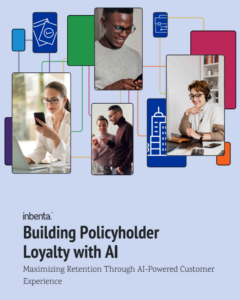We humans have been communicating for centuries using the most varied and surprising methods.
It is nowadays difficult to imagine prehistoric human species drawing inside caves as a way to tell other tribe members where to hunt or how to harvest. Yet, this was a common way of communicating during that era.
Since then, we’ve invented and created thousands of methods to talk—and sell—to each other. From messenger pigeons to the telegraph, to television infomercials, and finally digital messaging applications.
Conversations have always been crucial to sales. However, during the past few years, with the surge of marketing automation, there’s been a feeling that part of the conversation was lost in the way.
Was it the human touch we were missing? Or did it just seem like brands were spreading messages here and there without actually listening to what customers had to say? In any case, brands felt their strategies were lacking something. Something that could make consumers tick.
It is no coincidence that since last year, conversational marketing has been gaining momentum. Why? Because it resurrects the conversation and listening component we were missing while still using automated methods.
Conversational Marketing: What’s It Really All About?
Conversational marketing is a customer-centric approach that facilitates real-time, engaging, and personalized one-on-one interactions with customers, regardless of the channel they are using, in order to make the buyer experience more meaningful tailored to one’s needs.
This differs from other digital marketing approaches that bombard users with content simply based on their profile, without actually listening to their needs.
The ultimate goal of conversational marketing is to build strong, long-lasting customer relationships, improve customer experience and grow revenue while still keeping costs low.
Sounds great, right?
However, when adding all of your communication channels and existing platforms to the bowl, you might realize baking a successful conversational experience isn’t as easy as it might seem.
Implementing this approach across all channels (email, website contacts, social media messages…) might seem quite complex, plus the real-time component is really tricky, as providing 24/7 customer service isn’t cheap, is it?
3 Conversational Marketing Tools to Bring Your Strategy to Success
Chatbots: the ultimate 24/7 assistant
Chatbots, sometimes known as virtual assistants, have become an essential tool to power 24/7 digital interactions with consumers.
Not only do they cut costs by reducing the need of having an army of agents to reach out to customers and answer requests at all times, but they also simplify processes and eliminate repetitive and frustrating tasks.
Therefore, they are essential to Conversational Marketing, which sometimes leads these two terms to be confused.
However, to implement a successful Conversational Marketing strategy, a typical company might need to put several tools into play beyond chatbots to achieve the best results.
Live chat: a widely preferred channel
People love to chat and get instant responses, but a chatbot might not be able to handle 100% of them – although they are getting extremely close.
However, a live chat will help you build that unique 1:1 human interaction your customers might sometimes need, but still, allow them to choose their favorite channel as a communication method with your brand. Think Facebook Messenger, web chat, and so on.
Indeed, research shows text messaging is one of the preferred channels for consumers, and it’s no surprise, since it’s more informal than a call, and gives them more anonymity, while still mimicking a natural face-to-face conversation.
The essence lies in implementing a chatbot that is able to seamlessly escalate cases to a live chat, in an automated, yet appropriate way (we don’t want random, irrelevant requests to cause agents to lose their time, right?).
Social media channels are perfect for live chat purposes and can also work really well with chatbots, that can be integrated into channels like Whatsapp or Facebook Messenger.

Callbots: the future of IVRs
Yes, a conversational marketing approach can surely be implemented through voice channels.
Many brands have been using IVR methods for calls during the past decades, and that hasn’t been really satisfying for customers. More and more brands are embedding bots into their IVR systems in order to be able to respond to queries in a natural way, instead of making customers wait on the line while hearing an endless list of options on the voice menu until they find (or not) one that suits their needs.
Speech Matters: 2 Great Conversational Marketing Examples
So what does conversational marketing look like?
Well, it’s all about the words, about a good, engaging copy, that can promote dialogs between your customers and you. However, it is also about choosing a good solution that can help you scale these conversations across channels to reach all your user base.
So let’s see a couple of conversational marketing examples.
Benefit Cosmetics
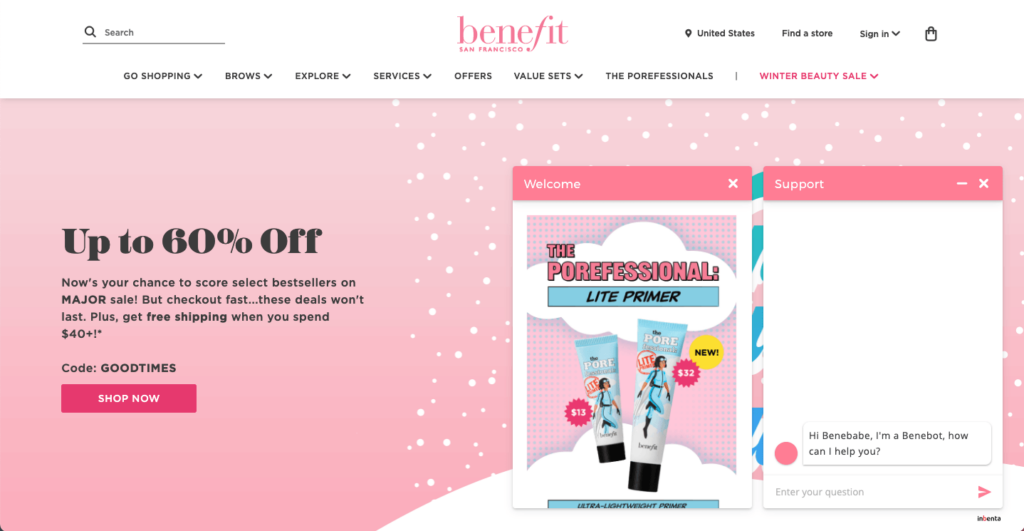
Benefit Cosmetics has a very clear branding and it transpires through their website chatbot. First of all, can we take a look at their welcome copy?
They are very upfront about the fact this is a chatbot, but they are nonetheless able to convey their coolness using words like ‘Benebabe’. Isn’t that a great way to start a conversation with consumers and make them feel closer to your brand?
They also use the chatbot channel to push special promotions and offers on a side bubble.
- On one side, it is a great promotion platform, since visitors using the chatbot are probably already looking to buy or get information about a product, so why not share with them your latest offer so they can maybe add that product to their carts as well?
- On the other, the fact it is pushed through the chatbot makes it stand out more and creates an illusion that the promotion is more targeted. So we say yes to their well-designed experience
Woolworths
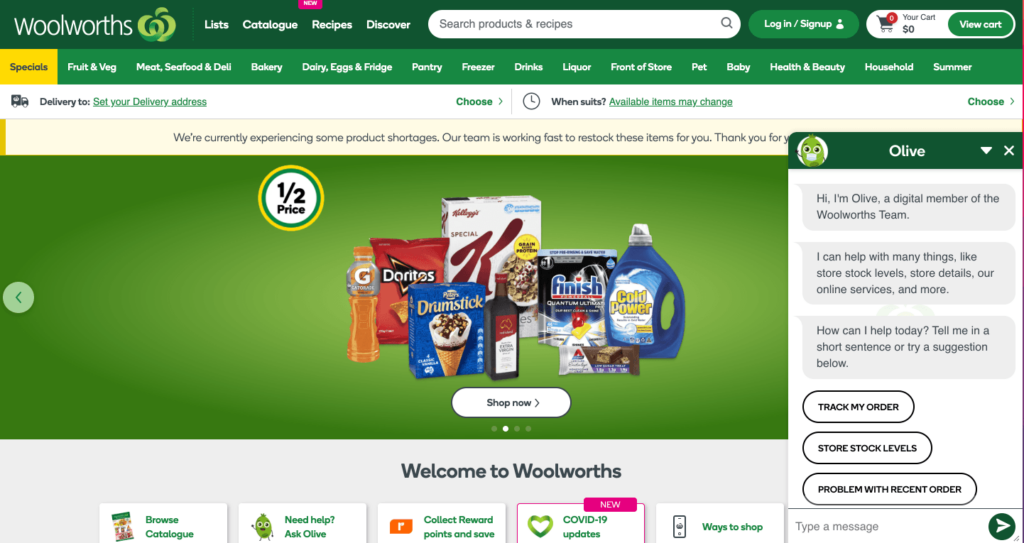
Another interesting example is that of Woolworths.
The retail company has a chatbot on its site that greets visitors in a funny way, describing itself as part of the Woolworths Team. This tiny detail, which could seem quite insignificant, actually makes Olive, the digital assistant, more human.
Another aspect that we believe fosters communication is that it actually tells people what to expect from its services. By introducing some of the things it is capable of, Olive is already trying to spark a conversation with the user.
Plus, the fact it shows a few clickable options also increases the chances of consumers to interact. As easy as it gets.
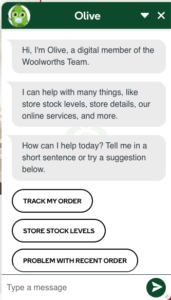
So let’s say we ask Olive whether or not there are slots available for today to order online and pick it up at the store:
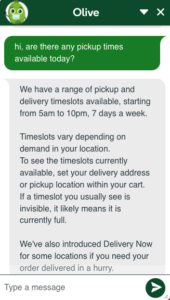
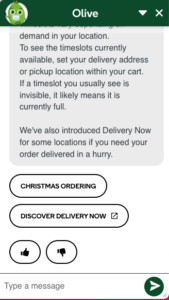
As we can see, not only Olive gives us the answer we expected but also takes advantage of the opportunity to introduce a new service called Delivery Now. This service might, in fact, be interesting, since we were requesting pick up for the same day.
Now, what does it happen if I ask Olive to talk to a real human?
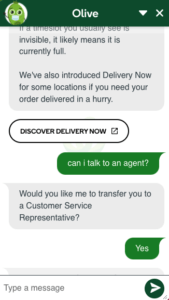
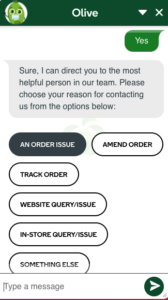
Well, Olive is able to escalate issues to an agent, but not only that. It can also pre-send agents some information on the user’s request.
Ready to build your own conversational experience?
If you’re looking to try it yourself and see how conversational marketing experiences work, just give Inbenta’s solution a go.
Chatbot, live chat, and AI-based knowledge centers with a human touch.




